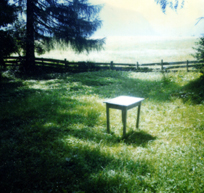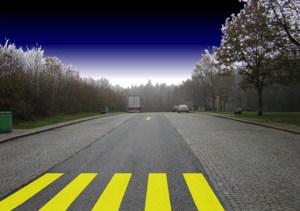
http://stream.mur.at:8000/kunstradio/mp3/2005A/10_07_05b.mp3
[ Deutsche Version ]
This early sound work by the author and music therapist Sabine Hassinger is a subjective contemporary document, a pleasantly down-to-earth sonic sketch of the time she spent and worked with patients at Steinhof, a psychiatrical clinic in Vienna. Original recordings of these sessions where the participants would chat with eachother, but far more often would sing are the basis for this piece which is also a hommage to the elderly patients.
By means of simple technical equipment Hassinger has edited the material for her artistic matters, has interwoven the material, played with delays, copied parts thus creating new contexts, and a specific dynamic. Once and again the lyrics „Das gibt’s nur einmal …“, which at the same time are the title for this piece are sung, sometimes as a choir, sometimes solo. In between these lines the quiet babble of voices, other songs. The clicking of the record button of the cassette recorder being switched on and off is audible; the technics are part of the artistic editing and give the piece its rhythm.
In 1988, Hassinger created a sonic memorial – her kind of way of saying goodbye to the patients at Steinhof – using this material for the installation. In 2005, she has now adapted the original recordings as well as recordings from this staging for the radio, re-arranging them to create the piece „Das gibt’s nur einmal“.
Statement of the Artist:
In spring 1988, I had been working as music therapist at Steinhof for seven years when I unexpectedly was allowed an arts grant for Berlin and thus decided to quit my job there. This wasn’t an easy decision, I loved the place, psycho-analysis and dealing with the history of psychiatry and its present condition and, most especially, working with the patients.
So, rather spontaneously, I created a sonic monument to the time I had spent there. I remember how I started operating all the primitive cassette recorders I could find in our large therapy room, plugged in and hooked up with multiple plugs and extension cables. First of all in order to copy a cassette with original recordings x-times, and to play these then in x-recorders with delays, at the same time recording this live event, effecting its dynamics and staging by fading in and out, by playing back and fast forward. I was deeply fascinated by the material and how almost every postponement of connecting parts and occasional harmonies can happen automatically, if one only has the courage to let this happen. As at the time, I was producing less decidedly and energetically than nowadays, it was something very special to start off in this way and obvious that the technical aspect and transformation should be audibly simple; at the same time I simply had no experience with other possibilities of realization.
The whole piece mostly takes place in day-night-clothes, so to say, in clothes which aren’t waiting for an exterior world, between beds, on chairs arranged in a circle and which were pushed from the dayrooms under great efforts; it often smelled of excreta, however the atmosphere which emerged in this kind of communication was greatly detached from space and time, the distant contents mixed with current issues of the psychiatry's daily routine. It is absurd that old people with typical, normal problems of aging are put away in psychiatrical clinics. This was a wunderfull ward, with highly committed nursing staff and mostly friendly doctors. However, it still remained Steinhof, and there were few chances of experiencing a daily life far from a hospital's routine.
Especially my work with the elderly was highly emotional; all the more, the delicate, tragical episodes seemed to need primitive technics and overlaps. I learned all the songs to be heard from the patients. I loved to entice these ancient treasures out of the (mostly) women and to elaborate a singable form together with them. Some women preferred to sing on their own, the others accepted and protected the fact. Some women are to be heard in this piece who remained silent otherwise, never mentioned a word.
Regarded from my present point of view, this acoustic work is an early example for my positive focus on the material itself and how it works. The sound of voices and melodies, texts, and in the order of events form and content are merged to one.
|

